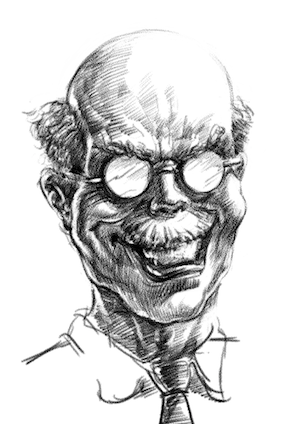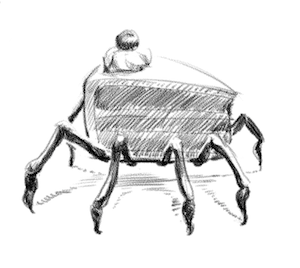Anxiety Engineering
2013-05-31
Our interview partner today is Prof. Dr. Dr. h.c. Manfred Pain. He is CEO of the institute for applied anxiety at the German Center for Advanced Dread (GCAD), founder of the Psycho-Economic Association for Increased Profits (PEAIP) and author of the consulting bible “FearForward”.

drewing.de: Prof. Pain, usually psychologists are trying to free their clients from anxieties. How is your method different from this?
Prof. Pain: It’s a shift of perspective. Take a look at the evolutionary function of fear – it’s really beneficial. These feelings helped our species to survive.
drewing.de: But we aren’t living in Neaderthal anymore, are we? In our modern world we have a lot less of wild animals threatening our lifes. And often these psychic forces aren’t helping, but hindering people.
Prof. Pain: You are totally right. And these forces are extremely powerful. That’s why traditional psychotherapy, as we see it today, is really wasting away a tremendous amount of psychic energy.
drewing.de: … and you found a way to preserve this energy?
Prof. Pain: Better. We can redirect it. It’s a bit like judo. We call this approach “functional fear”.
drewing.de: How does this work?
Prof. Pain: First we need to screen the psyche of the individual. We are exploring its deepest fears and searching for their triggers. These are events or things to whom the anxiety is attached to. Some methods from psychoanalysis come in handy at this point.
drewing.de: So, you are using classic methods?
Prof. Pain: Where appropriate, yes. Initially it’s really listening a lot, but we also have to prove our findings to be utilizable. This is where modern technology is added to the process: we are using augmented reality tools to test our findings. First the individual is being exposed to every day situations. Then we are augmenting these scenes with anxiety triggers. Indeed we are tuning the condition in order maximize the psychological reaction, mixing the existing triggers with the desired new triggers.
drewing.de: Critics called this “artificial hallucinations”. It must be a horror for the person going through this.
Prof. Pain: It’s a neccessary evil – we need to make sure the mechanism works well. For after we have implemented the new triggers into the individuals actual living environment, it’s quite a lot of work to readjust them.
drewing.de: Can you give an example?
Prof. Pain: Yes, of course. One of our first clients was a woman suffering from adiposity. No diet really worked for her, since her willpower was lacking. But she was lucky! We found that she had a very well developed fear of spiders. So we amplifed it a bit and joined the old trigger, spiders, with the desired new triggers: sandwiches, cakes, ice cream, etc.
drewing.de: And this worked?
Prof. Pain: Do you see the billboard over there?
drewing.de: You mean the lingerie advertising with this super hot babe?
Prof. Pain: Yes – the model you see there is our client.
drewing.de: Amazing!
Prof. Pain: Fascinating, yes, but this was only a proof of concept. The full power of our method shows when applied to larger groups. Multinational companies for example.
drewing.de: You can’t really put all employees of a multinational company on the couch, can you?
Prof. Pain: No. And we don’t need to. We can work with some abstractions in this environment. Remember: we are talking about work. It’s an anxiety engineers El Dorado!
drewing.de: Could you illustrate this a bit more?
Prof. Pain: Sure. At first we need to know what our client needs. We need to identify the key behaviour, which, when implemented, leads to the desired outcome by applying our methods to the companies employees.
drewing.de: Don’t you think that this is ethically problematic?
Prof. Pain: It’s 100% legal. I like to compare it to topography – imagine a height map, where the height is the amount of fear generated by a certain situation, person or trigger. Usually the peaks are somewhere around bosses, clients and such ilk.
Employees are like water. With the proper anxiety engineering in place we simply make sure that the altitude of the surrounding area is much, much higher. Yet, to them it looks like they still can go wherever they want.
drewing.de: How would this look like being implemented?
Prof. Pain: That depends upon the situation. Controlling the media is key in any case. The people must be made to feel like they are on the brink of an economic catastrophe. Or rather an economic apocalypse which will end all civilization. But don’t be too specific or you might create doubts.
On a micro level methods can involve the design of pension plans or even marital issues. Make sure your male employees have dreadful wives and they will be longer at work.
drewing.de: With all the gloom and pressure building up, won’t you risk suicides among the employees?
Prof. Pain: This can indeed be a problem. But it mustn’t. See, if employees are cheap as dirt you simply open the door and let the next willing idiot in. Some big players in the advertising industry developed this tactic to perfection. They are telling their unpaid interns that having the name of their slaver listed in their cv is a sign of excellence. It’s really funny what people are willing to do when they are suffering from dyscalculia (laughs).
drewing.de: What if you can’t substitute employees so easily?
Prof. Pain: Just apply the same technique: If we want to restrain the employees from committing suicide we simply need to put something in place that makes suicide look worse than their living conditions. Religion can be very useful in this case. If they believe suicide will condemn them to eternal suffering, suffering only one single lifetime looks certainly better.
Or getting their families and children into the deal might work as well. Really, the possibilites are endless, even within legal bounds (laughs).
drewing.de: Prof. Pain, thank you for your time and insights.
Prof. Pain: No problem, thanks for having me here.
[Yes, this is satirical]
